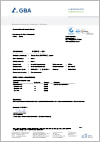Magnesium Complex 11 ULTRA
Magnesium Glycinate
Magnesium glycinate is bound to the amino acid glycine, which can be found in large amounts in connective tissue and in the brain. Magnesium glycinate is considered to be one of the most bioavailable magnesium compounds, and it contributes to normal protein synthesis, normal functioning of the nervous system and normal psychological function.
Magnesium Taurate
Magnesium taurate is bound to the amino acid taurine, which can be found in large amounts in muscle and eye tissue and in the brain. Magnesium taurate contributes to a reduction of tiredness and fatigue, normal protein synthesis and normal muscle function.
Magnesium Lysinate
Magnesium lysinate is bound to the amino acid lysine and is characterised by the special properties of L-lysine as well as by its extremely high solubility, the combination of which results in an exceptionally high absorption rate.
Magnesium Citrate
There are two forms of magnesium citrate: one which contains approximately 7% magnesium and the other with approximately 15%. The tri-magnesium dicitrate in this formulation, valued for its exceptional bioavailability and fast absorption, is the latter form with 15% magnesium. Magnesium citrate is alkalising while contributing to normal energy-yielding metabolism, normal muscle function, electrolyte balance and normal protein synthesis.
Magnesium Malate
Magnesium malate is a salt of malic acid and contributes to a reduction of tiredness and fatigue, normal energy-yielding metabolism and normal functioning of the nervous system.
Magnesium Gluconate
Magnesium gluconate is a salt of gluconic acid, a naturally occurring compound which can be found in kombucha. Magnesium gluconate is highly bioavailable and contributes to normal energy-yielding metabolism and the normal functioning of the nervous system. It also has a role in the process of cell division.
Magnesium Lactate
Magnesium lactate is an organic magnesium compound with a dextrorotatory lactic acid (lactate) bond. Dextrorotatory lactic acid is a natural human metabolic product and is also produced by lactic acid bacteria. Lactate is a component of the acid mantle of the skin as well as of the lactic acid intestinal environment, serving to nourish butyrate-forming intestinal bacteria while being an important source of energy for the cells of the intestinal mucosa.
Magnesium Ascorbate
Magnesium ascorbate, also known as buffered vitamin C, is a salt of ascorbic acid (vitamin C). It is very well tolerated and exhibits high bioavailability.
ConcenTrace® Mineral Concentrate
ConcenTrace® is a natural, highly bioavailable mineral concentrate sourced from the unique Great Salt Lake in Utah, USA. It contains 72 naturally occurring ionic minerals and trace elements. Among these are 36% magnesium chloride, along with other minerals and trace elements that serve as natural cofactors.
Magnesium Oxide
Magnesium oxide stands out with an impressive 57% magnesium content, far surpassing the typical 5–10% found in other magnesium compounds due to the single oxide atom bond. The chemical reaction between magnesium oxide and the hydrochloric acid present in the stomach produces magnesium chloride and water, thereby neutralising stomach acidity at high doses. This characteristic makes it less advisable for individuals with low stomach acid levels.
Sango Coral
Sango coral contains bioidentical organic calcium carbonate and magnesium carbonate, two compounds known for their remarkable bioavailability. This natural coral offers an optimal calcium to magnesium ratio of approximately 2:1, allowing the body's cells to absorb these compounds particularly well.
According to the European Food Safety Authority (EFSA):
Magnesium contributes to:
- a reduction of tiredness and fatigue
- electrolyte balance
- normal energy-yielding metabolism
- normal functioning of the nervous system
- normal muscle function
- normal protein synthesis
- normal psychological function
- the maintenance of normal bones
- the maintenance of normal teeth
- and has a role in the process of cell division







































